Docx files for personal book: Verbum 9 part 1; Verbum 9 part 2; Verbum 9 part 3; Verbum 9 part 4; Verbum 9 part 5; How to use the Verbum Lectionary and Missal; Verbum 8 tips 1-30; Verbum 8 tips 31-49
Reading lists: Catholic Bible Interpretation
Please be generous with your additional details, corrections, suggestions, and other feedback. This is being built in a .docx file for a PBB which will be shared periodically.
Previous post: Aside: Comparison translations part 1 Next post: Aside: Comparison translations part 3
Notes and footnotes
Notes and footnotes often contain information relevant to the differences in translation. When the resource is in scroll mode, the mouse-over function shows the contents of the notes:
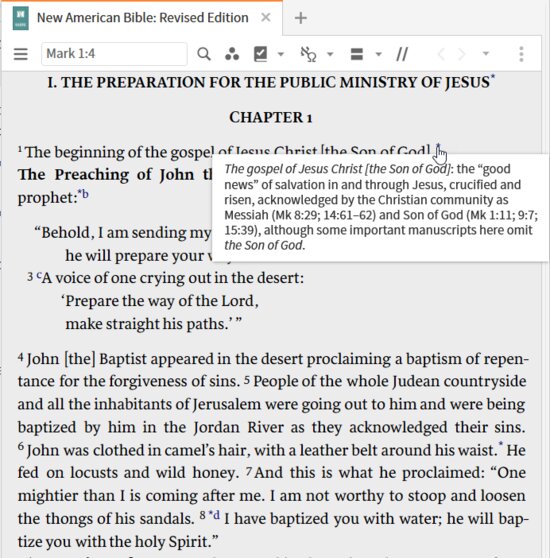
Notes and footnotes: Page mode
If you wish to read the notes at the bottom of the page, the resource must be in page mode:
- In the panel menu, set the number of columns to something other than “none”. I use “1”.
- Select “Show footnotes on page”
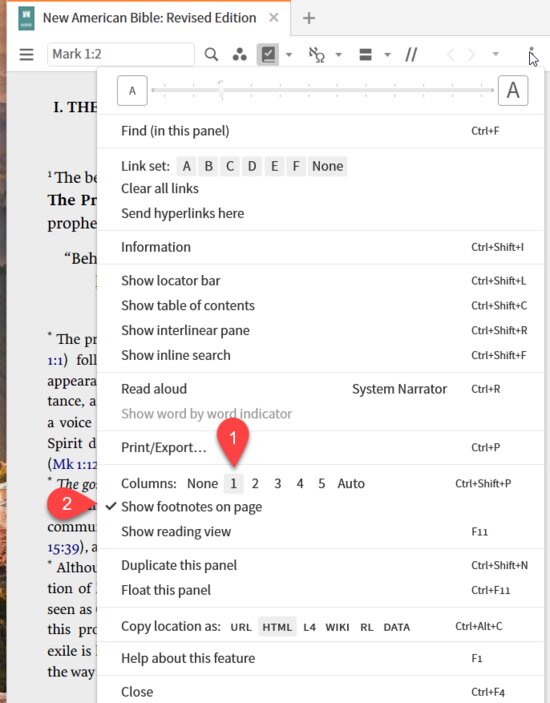
This results in:
- Notes at the bottom of the page
- Navigation by page rather than scroll bar
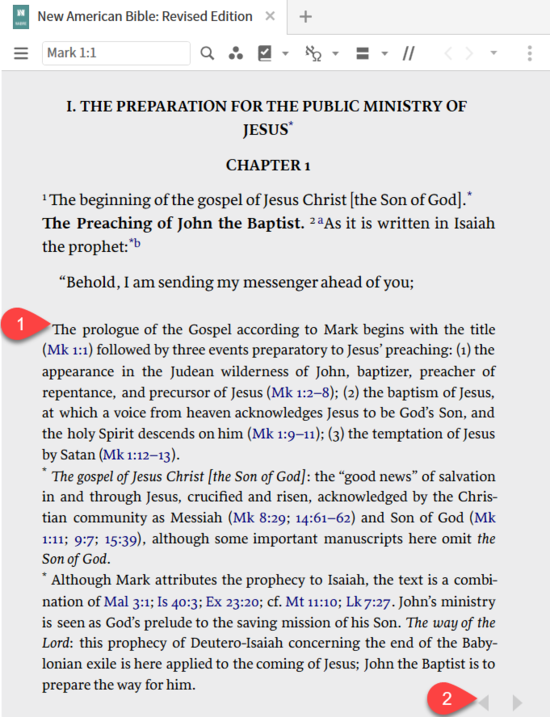
Notes and footnotes: Power lookup
The third view is by selecting the Power Lookup Tool from the tool menu (Tool à Lookup à Power Lookup). In this view, the Power Lookup panel will follow the text, showing the contents of the footnotes. As a bonus, it also looks up and displays references within those notes.
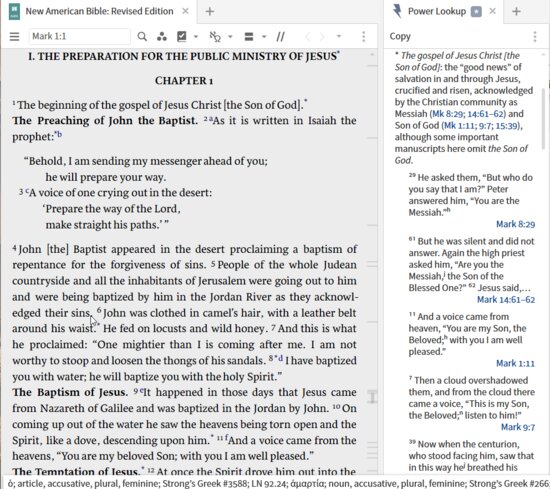
Comparison tools
There are several tools that assist in identifying differences but explaining those differences may require a full toolbox of historical, linguistic, cultural, and theological tools. See, for example, “’A Dark Speakyng’: English Translations of 1 Corinthians 13:12 and What We Can See in Them” by Curtis Gruenler.
Text comparison
From Verbum Help:
[quote]Text Comparison
Compare Bible translations side by side. Choose versions and view options in the toolbar.
1. Click Tools > Passage > Text Comparison
2. Click into the Reference box and type a passage.
• A verse map can be specified with a Bible reference to use when parsing (for example, type BHS Psalm 3:1 to compare the Psalm title that comes before verse 1 in most English Bibles). This also works with other texts that have the same mapping (i.e., Early Church Fathers, Code of Hammurabi).
3. Choose Bible versions or texts to compare.
• Type the name or abbreviation to filter Bibles or other resources, and select the checkbox for the desired Bibles.
• Drag titles up or down to choose the order they display in.
• Click outside the pop-up for those selections to be applied.
4. If the user owns a collection that includes the Compare Parallel Bible Versions feature, two additional options will display:
• To display the differences between versions, click the a next to the passage box.
• With Show differences enabled, users can also Show base text with the other texts by clicking the a to the right.
5. Open the panel menu to choose Layout and Ignore options from the menu:
• Automatic layout
• Horizontal layout (columns)
• Vertical layout
• Ignore case
• Ignore marks
• Ignore punctuation
Interlinear View [Net]
Click Verses to switch to Interlinear mode (New Testament only), which will compare different translations line by line. Interlinear view will only work with translations that have a reverse interlinear.
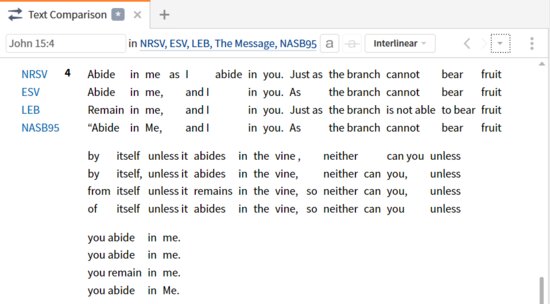
Quick Verse Compare
To see a quick comparison of a passage from an open Bible or commentary, press F7 in Windows and Mac. It isn’t necessary to have the Text Comparison tool open for this to work.
Print/Export
Print/Export is only available in Verses mode.
1. Open the Text Comparison anel menu and choose Print/Export. Users can also press Cmd+P (Mac) or Ctrl+P (Windows).
2. Click Print or Copy to the clipboard, or save as Rich Text Format (Word, etc.), Text Document, Web Page (HTML), PDF Document (Mac), or XPS Document (Windows).
See Also
• Text Comparison: Dataset Documentation[1]
In horizontal (column) layout with differences marked:
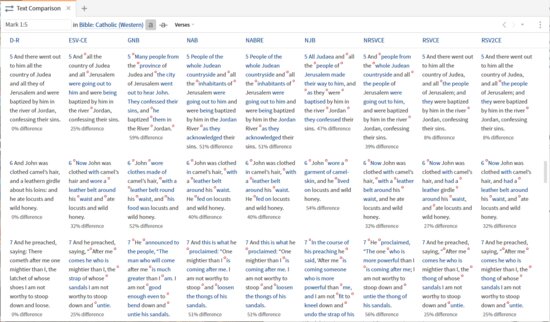
In vertical layout with differences marked:
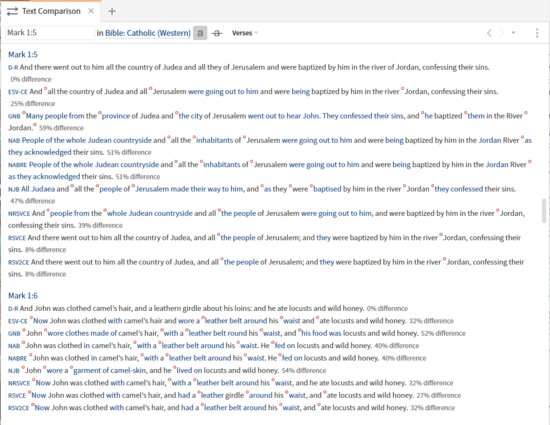
Notes:
- By using a collection, one gives up the ability to control the sequence of the entries
- Two Bibles were excluded from the collection to make this work. The first Bible in the comparison must have the passage one is requesting – two Catholic Bibles are of single Old Testament books.
- The screen shots above ignore case, marks, and punctuation as shown in the options of the Panel Menu
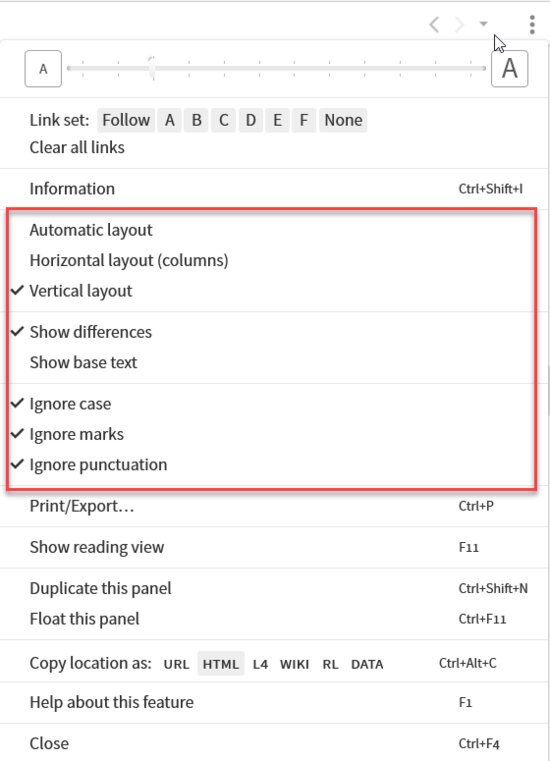
- The tool leaves it up to the user to identify the type of differences, the probable cause of the difference, and the significance of the difference.
Information panel: Translation
From Verbum Help:
[quote]Information
Hover over or click any word in a linked panel to display additional information about it here.
To access the Information tool:
1. Click Tools > Lookup > Information. The Information panel will open on the right. Users can also right-click a word or reference and choose Show Information from the Context menu.
2. In any open resource, hover over a word or data type reference link. An entry from a dictionary, lexicon, or encyclopedia may appear in Information, as well as the text of references and footnotes, speaker labels, and palette/style names of applied highlighting.
3. Hovering over another word in the text will display information on the new word. To move the cursor without changing the content, hold the Cmd key (Mac) or Ctrl key (Win).
4. Click a link in the Information panel to open the resource to the referenced location.
5. Click Copy to copy the content of the panel to the Windows clipboard for pasting into a note or a document. Users can also click one entry to select it and copy that entry only.
To change the way information in retrieved, open the panel menu , and select the desired option under Update on:
• hover: updates information automatically when the user hovers over a word for a few seconds (default)
• click: updates information only when a word is clicked
Sections
The Information tool is divided into several sections. These sections can be expanded, collapsed, rearranged, or removed. The Add button in the top-right allows users to replace any removed sections.
The available Information sections are:
Definition
This section provides the definition for the selected word for Surface text or original language lemmas, in addition to the Strong’s Number, and Louw-Nida.
The Settings option, when mousing over the section header, allows users to choose between Brief or Entire definitions, as well as selecting the preferred Lexicon.
Translation
This section displays how the selected word is translated in other versions of the text. This will generally consist of prioritized Bibles and interlinear resources.
. . .
Print or export the Information panel content:
1. Open the Information anel menu.
2. Choose Print/Export; users can also press Cmd+P (Mac) or Ctrl+P (Windows).
3. Click Print, Copy to clipboard, or save as Rich Text Format (Word, etc.), Text Document, Web Page (HTML), or XPS Document.[2]
The Information Panel, in its Translation section, summarizes all the translations of a word across one’s Bible resources. In this case, the English variations have been highlighted with red boxes. This summarized data provides a strong base for identifying detailed differences worth exploring.
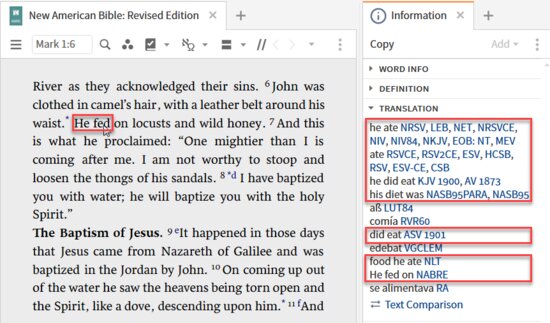
[Net] Some or all of the features in this section require a live internet connection to be fully functional.
[1] Verbum Help (Bellingham, WA: Faithlife, 2018).
[2] Verbum Help (Bellingham, WA: Faithlife, 2018).